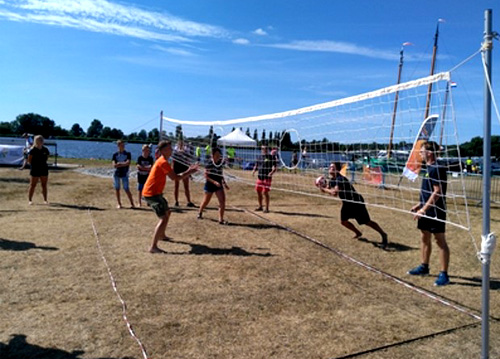Info
This sport consists of throwing the ball with two hands through three holes (rings) in the net. The middle one is the largest (diameter 70cm) and two side ones 50 cm each. There are usually
4 players on each side of the court. Three players are in the back (behind a line 1.5 meters from the net). Their task is to catch the ball and pass it to the other players of their team or throw through the holes in the net.
The game begins with a serve from the end line of the court. The server hits the ball above the net, like in volleyball. Then, however, the opposing team has to catch it and either pass or throw the ball through one of the holes.
The fourth player is the playmaker. He or she stands in the 1.5-meter zone closest to the net. His or her task is only to pass the ball to other players of his/her team. He/she cannot throw it through the holes or block them with his/her own body. After each action, there is a rotation of players – they change their positions so as everybody could serve, be a playmaker and throw the ball through all the holes.
You usually play best of 3 or best of 5 sets up to 15, 21 or 25 points each (except for tie-breaks up to 15 points). Of course, it can be easily changed depending on the needs
History
Pierścieniówka was invented by Włodzimierz Robakowski, Polish PE teacher, in the 1930s.
Robakowski was watching the fishermen, playing on the Mazurian Lakes (the biggest complex of lakes in Poland). They were throwing buoys through broken, leaking nets, which were no longer used for fishing. Inspired by this, he decided to check how to throw the ball through a similar net.
This Polish teacher already knew volleyball, which was founded in the late nineteenth century in the United States by another teacher – William Henry Morgan – as a part of physical education in local schools.
Robakowski used a net in which he cut out three holes resembling those ones from the fishing nets.
Physical abilities developed
motor skills: coordination and body balance, accuracy of throws, passing and catching techniques, reaction speed; social: quick decision-making, teamwork skills; cognitive: building a strategy, developing tactical thinking;


